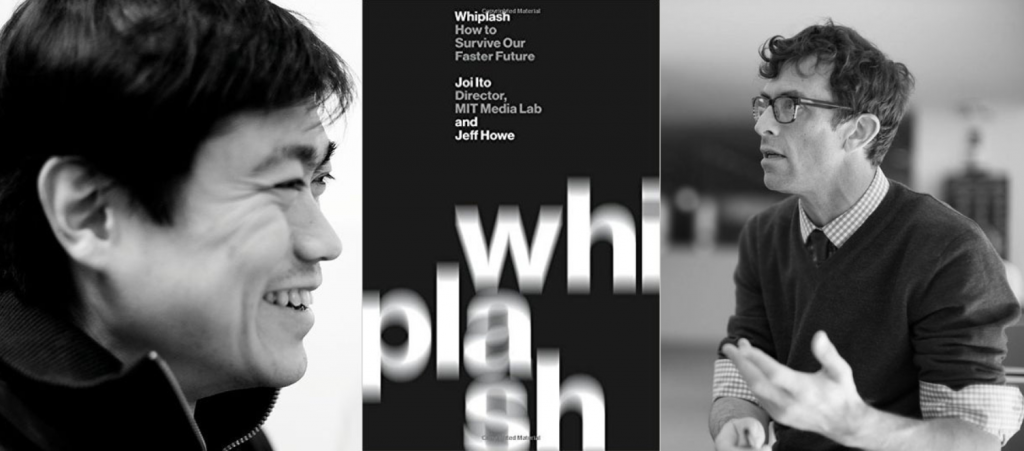Preparing Learners for a Faster Future: 9 Principles for “What’s Next” in Learning
“Education is something that is done to you. Learning is something you do for yourself.” Joi Ito
Have you heard of Moore’s Law? Moore’s Law is the premise that everything digital gets faster, cheaper, and smaller at an exponential rate. I recently read the book Whiplash: How to Survive our Faster Future by Joi Ito, Director of MIT Media Lab, and Jeff Howe, associate professor at Northwestern University and former writer at Wired Magazine. The book deals with complex subjects: bitcoin, blockchain and cryptography as well as genetics, machine learning (also referred to as deep learning) and artificial intelligence. The premise of the book is that technologies have outpaced our ability as a society to understand them and that we now need to learn more and catch up. The authors write: “Our current cognitive toolset leaves us ill-equipped to comprehend the profound implications posed by rapid advances in everything from communications to warfare.”
At GOA, we’re looking ahead to our latest professional learning pop-up course, Learning Now, and as I read Whiplash, I kept one central question in mind: How might schools need to adapt for a faster future?
The authors describe nine principles that we face in the coming years. I’ve made connections to the principles and the field of education.
Emergence over Authority
There’s a profound shift away from authority, where some organizations or people own all knowledge, to emergence, where decisions aren’t made so much as emerge from large groups of people.
The authors write, “All of these advances are creating a de facto system in which people are empowered to learn, design, develop, and participate…Emergent systems presume that every individual within that system possesses unique intelligence that would benefit the group. This information is shared when people make choices about what ideas or projects to support.”
Examples include Encyclopedia Britannica vs. Wikipedia; Kickstarter; Indiegogo; any time people can learn on their own for free (edX, Khan Academy).
Potential impact: Content is now co-created in a faster future.
Pull over Push
Power is moving away from the core to the edges. Rather than stockpiling resources and information, innovation is now happening at the edges. Resources are pulled in as needed
Example: old AOL model was push-based and attempted to provide consumers with a full range of services while controlling access to the network. Examples of pull include crowdsourcing and freelancing to pull in teams of people to solve a problem or create a prototype as needed.
In education, our traditional education system rewards focus and completion rather than problem solving. Students spend too much time focused on solving problems we already know the answers to rather than imagining and exploring problems we do not have the answer to.
Potential impact: Learning organizations join together in networks to pull in people and resources to solve problems as needed.
Compasses over Maps
A map implies knowledge of the land, and the existence of an optimal way to get from point A to point B. A compass is more flexible and it requires creativity and wayfinding to discover a journey.
The authors write, “The decision to get rid of the map in favor of a compass recognizes that in an increasingly unpredictable world moving ever more quickly, a detailed map may lead through places you don’t want to go. A compass is more personalized to your own journey.”
Potential impact: Students create personalized learning journeys.
Risk over Safety
The new rule is to embrace risk. Companies such as Facebook and Google have leveraged risk to remain agile and resilient. How might we encourage students to take risks? Are schools designed in such a way as to promote risk taking? Schools that allow students to pursue risk (perhaps projects with unknown outcomes) enable students to encourage creativity.
The authors make the point about how investors make money: buy low, sell high. The buy low and sell high version of education is to try to find an emerging field where you have an unfair advantage and a passion. This might feel risky, but, the authors write “you are much more likely to find yourself at the top of an emerging field with less competition, and in the worst case, you still end up doing something you enjoy.”
Potential impact: Leadership makes decisions to design for risk and novelty.
Disobedience over Compliance
When Ito helped found the first Internet service provider in Japan, attorneys for the telecom industry wrote letters telling him he couldn’t. He did it anyway. Disobedience over Compliance emphasizes agile and permissionless innovation. The authors write, “You don’t win a Nobel a Prize by doing as you’re told.”
Teaching students when and how to disobey and why they should is critical. As the authors point out, the civil disobedience era of the Civil Rights movement in the 1960s was obviously positive, but there is a line between what helps society and what doesn’t when it comes to disobeying.
Potential impact: Opportunities to discuss ethical and moral implications of change.
Practice over Theory
There’s a cost to waiting and planning than there is to doing and improvising. Launching new ideas has dropped dramatically in price. Do not need to wait for permission or explain yourself before you begin. An example of practice over theory is Google’s 20% time devoted to interest-based projects.
In schools, this looks like an emphasis on learning by doing. Practice needs to take a front seat ahead of testing. Schools that emphasize problem solving, innovation, and the skills required to produce new knowledge will have children that will do well in a global system: “When we talk about learning — as opposed to education — we’re talking about replacing the traditional one way top down model of knowledge transmission with an active, connected system that teaches people how to learn.”
Consider the following quote and the implications for learning systems: “A learning-oriented system values students’ interests, and gives them the tools they need to discover and pursue them. In formal educational institutions, these systems can still be guided by evidence-based approaches to pedagogy and sequencing, while allowing students room to construct their own curricula, seek out mentors, and share their knowledge with their peers… The people who will be the most successful in the coming decades will be those who can tap into their networks to learn the things they need to meet the new challenges as they arise.”
Potential impact: Students engage in interest driven-learning (practice) which will help them grasp tedious aspects of theory. Students with a passion for learning will be able to teach themselves things they need to know.
Diversity over Ability
Organizations should promote the hiring to ensure diversity of staff. The authors write, “a bigger circle benefits us all.” There is a sense, particularly among young people, of a bent towards justice. Our organizations need to be more just and aware of gender and racial disparities in our schools and workplaces, and work aggressively to promote justice. The system has been designed to work against many groups of people. We should right the wrongs of the past.
Potential impact: Increased recognition of diversity as a value-add to schools and organizations.
Resilience over Strength
Focus on resilience over strength in business helps organizations develop vibrant, robust, dynamic systems. In education, we should emphasize building resilience in students, not the need to be dominant, strongest student, or top of the GPAs. Students need to be adaptable and flexible in the face of failure, able to navigate the unexpected, and rise to challenges.
Potential impact: Schools promote resilience in students, de-emphasizing the need to earn top grades.
Systems over Objects
Innovation requires more than speed and efficiency. It also requires a constant focus on the overall impact of new technologies and an understanding of the connections between people, their communities and their environments. The drive towards innovation needs to consider ecological, social, and network effects.
There is a shift away from creating objects to building relationships by expanding networks of human knowledge and initiative building. Every innovation must consider its effect on the entire global network.
Steve Jobs of Apple famously suggested that the designers “start with the customer experience and work backwards to the technology.”
Potential impact: Design of schools starts with the student experience, and works backwards to the design of school.
Below, I have summarized the principles, questions I have for the design in schools and the impact each trend may have on education.
| Principle | Example | My Question | Potential Impact |
| Emergence over Authority | Wikipedia; Kickstarter | How might learning experiences we design foster collaborative learning and emergence of new ideas, rather than a focus on existing knowledge and content? | Co-created content. |
| Pull over Push | Crowdsourcing, freelancing | How might students explore and pull in people and ideas through their network rather than work on solutions to problems we already know the answer to? | More networks to pull in people and resources to solve problems as needed. |
| Compasses over Maps | Innovators who prioritize agile, nimble businesses; wayfinding | How might we teach students to navigate ambiguity and the unknown? | Personalized learning journeys. |
| Risk over Safety | Innovators who push to disrupt entire industries (Netflix, Amazon) | Are schools designed to allow for strategic risk taking? | Leadership moving away from traditional top down authority to more being a steward of people and ideas. |
| Disobedience over Compliance | Civil disobedience movements; Nobel Prize winners (many innovators strategically break rules) | How might we allow for disobedience in ways that are ethical and for the “better good”? Who defines when it’s ok and not ok to be disobedient? | Increased teaching of ethical implications of change. |
| Practice over Theory | Google’s 20% time, Genius Hour; unbundling of education | How might schools be designed for practice, play, and passion? | Students engaging in interest driven-learning (practice) which will help them grasp tedious aspects of theory. Students with a passion for learning will always be able to teach themselves things they need to know. |
| Diversity over Ability | Promoting diversity in hiring | How might schools promote and encourage diversity? How might work work towards becoming a more just society? | Increased recognition of diversity as a value add to schools and orgs. |
| Resilience over Strength | Cybersecurity that is agile and nimble to cyber attacks | How might we foster resilience in students? | Resilience in students— de-emphasizing the need to be dominant, strongest student, or top grades, but rather adaptable and flexible to failures. |
| Systems over Objects | Steve Jobs’ emphasis on user experience; using human-centered design principles | How might any learning innovations consider systemic effects such as ecological, social, and network impact? | Design of schools to start with the student experience, and work backwards to the design of school. |
What impact do you think these nine principles are having or will have on education? Write to us at hello@globalonlineacademy.org with the title “faster future” or tweet at us @GOALearning.
Global Online Academy (GOA) reimagines learning to empower students and teachers to thrive in a globally networked society. Professional learning opportunities are open to any educator. To sign up or to learn more, see our Professional Learning Opportunities for Educators or email hello@GlobalOnlineAcademy.org with the subject title “Professional Learning.” Follow us on Twitter @GOALearning. To stay up to date on GOA learning opportunities, sign up for our newsletter here.

